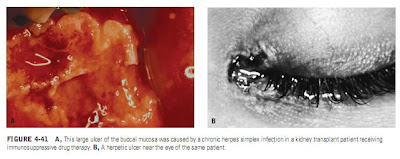The most common cause of single ulcers on the oral mucosa is trauma. Trauma may be caused by teeth, food, dental appliances, dental treatment, heat, chemicals, or electricity (Figure 4–43). The diagnosis is usually not complicated and is based on the history and physical findings. The most important differentiation is to distinguish trauma from squamous cell carcinoma. The dentist must examine all single ulcers for significant healing in 1 week; if healing is not evident in this time, a biopsy should be done to rule out cancer. (Cancer of the mouth is discussed in detail in Chapter 8.)
Infections that may cause a chronic oral ulcer include the deep mycoses histoplasmosis, blastomycosis, mucormycosis, aspergillosis, cryptococcosis, and coccidioidomycosis as well as a chronic herpes simplex infection. Syphilis, another infection that may cause a single oral ulcer in the primary and tertiary stages, is described in Chapter 20.
The deep mycoses were rare causes of oral lesions prior to HIV infection and immunosuppressive drug therapy. The dentist must consider this group of diseases in the differential diagnosis whenever isolated ulcerative lesions develop in known or suspected immunosuppressed patients. Biopsy of
